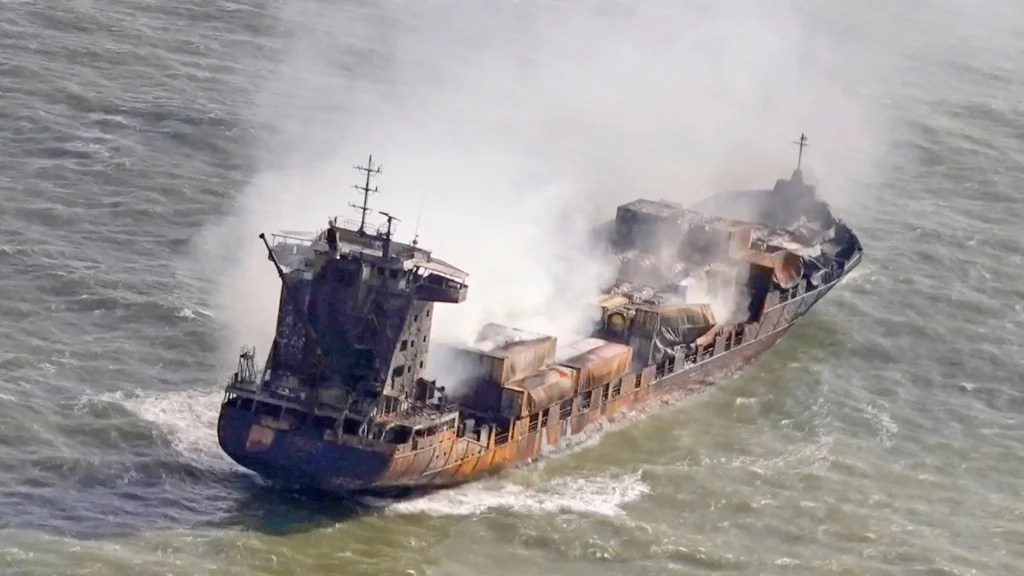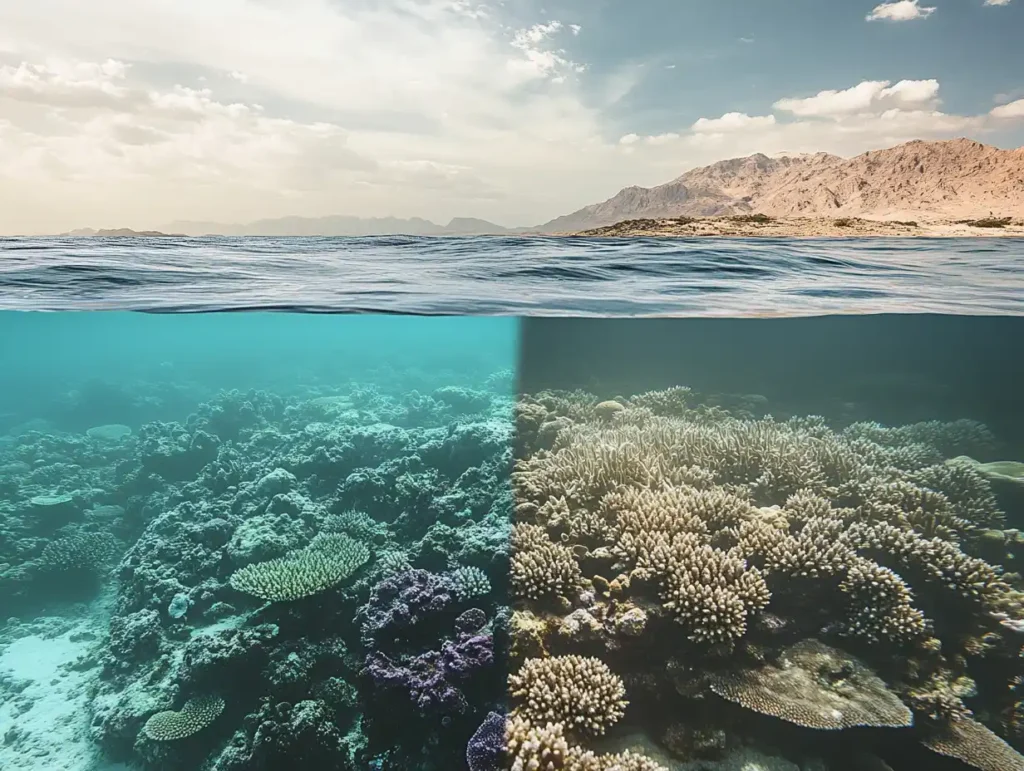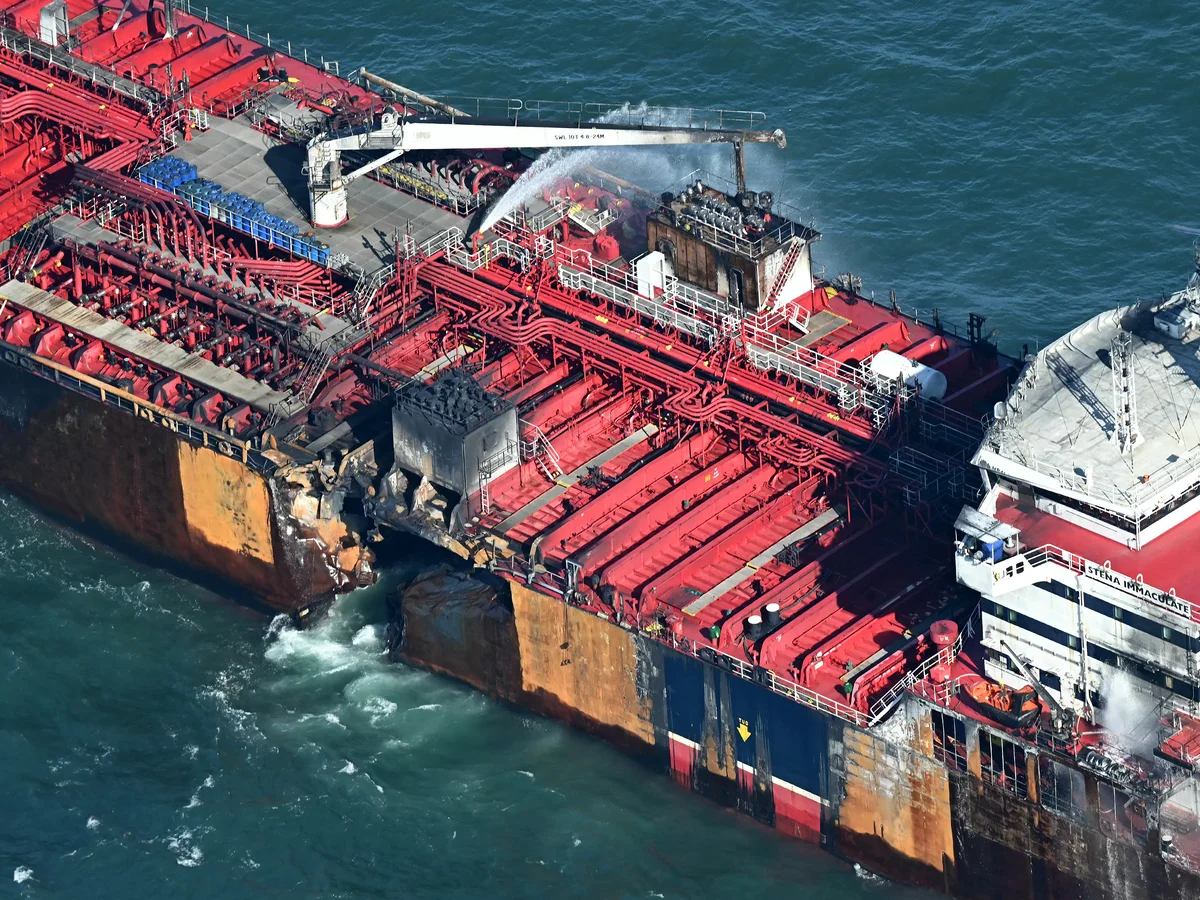The March 2025 North Sea oil spill resulted from a collision between two ships. The cargo ship Solong hit the tanker Stena Immaculate. This released thousands of gallons of aviation fuel into protected marine areas. This North Sea oil spill joins other recent maritime disasters like the December 2024 Black Sea mazut spill that devastated coastal ecosystems. The North Sea faces ongoing risks from both major oil spill incidents and chronic smaller leaks due to its busy shipping lanes and extensive oil infrastructure. Effective prevention of North Sea oil spills requires stronger safety measures, better response capabilities, and international cooperation to protect this vital marine environment.
Why the North Sea Faces Oil Spill Risks
The North Sea has become particularly vulnerable to oil spills due to three major factors. First, the region contains extensive oil and gas infrastructure with hundreds of offshore platforms. It has thousands of miles of underwater pipelines and numerous processing facilities. This concentration of oil-related activities increases the chances of operational accidents and potential North Sea oil spills.
Heavy Maritime Traffic
Second, the North Sea serves as one of the world’s busiest shipping routes. Thousands of vessels navigate these waters daily. These include oil tankers, cargo ships, and fishing boats. With such heavy traffic, the risk of collisions and accidents that could lead to North Sea oil spills rises significantly.
Challenging Weather Conditions
Third, the North Sea’s harsh weather creates dangerous conditions. These can challenge even experienced crews. Frequent storms, dense fog, and strong currents make navigation difficult. These conditions can contribute to accidents. They also complicate cleanup efforts when North Sea oil spills occur.
Together, these factors create an environment where both major spills from accidents and smaller chronic leaks pose ongoing threats. They endanger marine life and coastal communities.

North Sea Oil Spill 2025: The Stena Immaculate Collision
On March 10, 2025, at approximately 9:48 AM, a serious maritime accident occurred in the North Sea. It happened about 14 nautical miles northeast of Spurn Head, off the coast of East Yorkshire, UK. The US-registered oil tanker Stena Immaculate collided with the Portuguese-registered container ship Solong.
Vessel Details and Cargo
The Stena Immaculate was a substantial 183-meter-long vessel. It was anchored when the collision occurred. It carried approximately 220,000 barrels of Jet A-1 aviation fuel. This was under charter to the US Navy.
The Solong was a smaller container ship at about 140 meters. It was traveling from Grangemouth, Scotland to Rotterdam, Netherlands when it struck the anchored tanker.
The Collision and Immediate Aftermath
The violent impact caused fires to break out on both vessels. Approximately 17,515 barrels of aviation fuel spilled into the sea. This came from a damaged cargo tank on the Stena Immaculate.
The collision also resulted in the release of plastic nurdles. These are small plastic pellets used in manufacturing. They spilled from containers aboard the Solong.
Human Impact and Investigation
Tragically, one crew member from the Solong went missing after reportedly entering the water. He was a 38-year-old Filipino national named Mark Angelo Pernia. After an extensive search operation, he was presumed dead.
The captain of the Solong, 59-year-old Russian national Vladimir Motin, was arrested by Humberside Police. He was later charged with gross negligence manslaughter.
Potential Security Concerns
The involvement of a Russian captain raised additional questions among investigators. This follows a pattern of Russian nationals being implicated in maritime incidents. In November 2024, Russian crew members were under scrutiny for Baltic Sea submarine cable disruptions. The investigation is examining whether this collision was purely accidental or potentially deliberate.
Western intelligence agencies have noted that Russia has increasingly used civilian vessels for hybrid maritime operations since 2014. Over 200 Russian ships have displayed suspicious behavior near critical infrastructure in the North Sea. While there is no conclusive evidence linking this incident to intentional sabotage, authorities are conducting a thorough investigation given the strategic importance of North Sea shipping lanes.
Early reports suggested the Solong might have been carrying sodium cyanide, a highly toxic chemical. This created additional concern. However, these reports were later refuted by the vessel’s owner.
Investigators are examining several potential causes of the collision:
- Possible autopilot failure on the Solong
- Fog or poor visibility conditions
- Human error in navigation
- Technical malfunctions on either vessel
Environmental Impact of the North Sea Oil Spill
The 2025 North Sea oil spill threatened two critical marine protected areas: the Southern North Sea Special Area of Conservation and the Holderness Offshore Marine Conservation Zone. These protected regions shelter important marine species and habitats that face particular risk from pollution.
Threats to Marine Mammals and Habitats
The Southern North Sea SAC provides crucial habitat for harbor porpoises, small whales that are sensitive to changes in their environment. Meanwhile, the Holderness Offshore MCZ protects ocean quahogs, long-lived clams that can survive for centuries, along with other valuable seafloor habitats and geological features.
When aviation fuel spills into the sea, it creates both immediate and lasting problems. Unlike thicker oils that form visible slicks, aviation fuel spreads quickly across the water’s surface. Though it evaporates and breaks down faster than crude oil, it remains highly toxic to marine life during this process. Fish, seabirds, and marine mammals can suffer from poisoning, skin irritation, and damage to their respiratory systems.
Secondary Pollution Concerns
Beyond the fuel, the plastic nurdles spilled during the collision present a different but equally serious threat. These small plastic pellets can be mistaken for food by fish, birds, and other marine creatures. When animals eat these indigestible plastics, they can suffer blockages in their digestive systems, malnutrition, and eventual starvation.
The North Sea also faces ongoing challenges from smaller, chronic oil spills. Records show that since 2011, over 215 spills have occurred within Scottish Marine Protected Areas alone, releasing more than 308 tonnes of various oils. The “leakiest” oil fields – Elgin, Foinaven, and Gannet F – account for most spilled oil in the Scottish North Sea, with many located in or near protected zones.

Comparing North Sea and Black Sea Oil Spill Incidents
The 2025 North Sea oil spill shares some similarities with the December 2024 Black Sea oil spill, but also differs in important ways. These differences help explain the varying environmental impacts and cleanup challenges.
Different Causes and Vessels Involved
The Black Sea incident occurred on December 15, 2024. Two aging Russian tankers broke apart during a severe storm in the Kerch Strait. The ships carried mazut, a thick and toxic heavy fuel oil. The Volgoneft-212 split in two and sank. The Volgoneft-239 ran aground with significant damage. This disaster released approximately 3,000 tonnes of mazut into the sea.
Unlike the North Sea collision caused by navigation errors or technical failures, the Black Sea spill had different origins. It resulted from operating outdated vessels in dangerous weather. Both ships were over 50 years old. They were reportedly part of Russia’s “shadow fleet” used to avoid international sanctions. The Volgoneft-212 had undergone questionable modifications that likely contributed to its failure.
Contrasting Environmental Impacts
The environmental consequences also differed based on the type of oil spilled. The North Sea’s aviation fuel spill evaporates and breaks down relatively quickly in water. While immediately toxic, it doesn’t persist as long.
In contrast, the mazut from the Black Sea disaster forms thick, sticky globules that remain in the environment for years. This heavy oil coated beaches, rocks, and marine life. It killed an estimated 15,000-20,000 birds and at least 70 dolphins by early 2025.
Response Approaches
Response efforts faced different challenges as well. The UK’s well-established maritime response system quickly mobilized to address the North Sea collision.
Meanwhile, the Black Sea cleanup relied heavily on volunteers who faced serious health risks from toxic fumes. Many critics pointed to what they considered an inadequate and delayed official Russian response.
Response and Cleanup Efforts for the North Sea Oil Spill
When the collision occurred in the North Sea, authorities launched a swift response to address the North Sea oil spill. The UK Maritime and Coastguard Agency (MCA) took the lead. They worked closely with the Royal National Lifeboat Institution (RNLI) and other authorities to manage the emergency.
Immediate Response Actions
Immediate priorities included:
- Containing the fires that erupted on both vessels
- Assessing the extent of pollution from the jet fuel spill
- Collecting spilled plastic nurdles from beaches
- Searching for the missing crew member
Salvage experts from SMIT Salvage quickly arrived to assess the structural damage to both vessels. They developed a plan for securing them safely. Their experience with maritime accidents proved valuable in preventing further oil release.
Special Challenges of Aviation Fuel
The response to aviation fuel spills differs from those involving heavier oils. Aviation fuel spreads rapidly but also evaporates more quickly. This makes containment booms less effective. Instead, response teams often focus on monitoring the natural dispersion while protecting sensitive areas and wildlife.
Long-term Monitoring and Protocols
The UK’s response capabilities benefit from well-established protocols developed through decades of North Sea oil and gas operations. Offshore operators must report all accidental releases within six hours. They use the Petroleum Operations Notice 1 (PON1) reporting system. The government monitors these incidents closely and can impose fines when necessary.
This incident demonstrated both strengths and challenges in the response system. Having ready response resources proved vital. Yet addressing North Sea oil spills in busy shipping lanes near protected areas remains difficult. The experience gained from this response will likely inform future improvement strategies throughout the North Sea region.
Prevention Strategies for North Sea Oil Spill Safety
Preventing future oil spills in the North Sea requires a comprehensive approach. Both industry practices and regulatory frameworks must continue evolving to better protect this vital marine environment from North Sea oil spills.
Historical Context of North Sea Pollution
This 2025 collision highlighted the ongoing risk of North Sea oil spills over the past decade. Data shows that since 2011, over 215 oil spills have occurred within Scottish Marine Protected Areas alone. These released more than 308 tonnes of various oils into sensitive environments. The March 2025 incident stands as one of the more significant North Sea oil spills in recent years due to its location and the amount of fuel released.
Improving Maritime Navigation Safety
For shipping safety, several key measures can reduce North Sea oil spill risks. Advanced navigation systems provide real-time information about nearby vessels and hazards. These help captains make better decisions, especially in poor visibility.
Improved traffic separation schemes organize ship movements in busy areas. They work similar to highway lanes for cars. Mandatory pilot programs in high-risk zones bring expert local navigators aboard to guide vessels safely.
Enhanced Monitoring and Maintenance
For offshore oil operations, regular inspection and maintenance of aging infrastructure helps prevent North Sea oil spills before they start. Companies are increasingly using digital monitoring systems that can detect small leaks early. This allows for repairs before major North Sea oil spills occur.
Stricter regulations on equipment standards and operational procedures also play an important role in preventing environmental damage. The 2025 collision highlighted the value of rapid response capabilities. Investing in well-trained emergency teams and strategically positioned equipment ensures faster action when incidents do occur.
Global Cooperation and Learning
International cooperation remains essential, as oil spills don’t respect national boundaries. Weather forecasting improvements can help vessels avoid the most dangerous conditions. Better communication between ships, platforms, and shore-based authorities allows for coordinated responses to developing situations.
Perhaps most importantly, learning from past incidents provides valuable insights for preventing future North Sea oil spills. The 2025 North Sea oil spill and the 2024 Black Sea disaster teach important lessons. Thorough investigations identify specific causes and systemic weaknesses that can then be addressed through targeted improvements.
Frequently Asked Questions
What caused the 2025 North Sea oil spill?
The exact cause of the North Sea oil spill remains under investigation, with potential factors including autopilot failure, fog conditions, human error, or technical malfunctions. The captain of the Solong has been charged with gross negligence manslaughter, suggesting human error may have played a significant role.
How much oil was spilled in the 2025 North Sea oil spill?
Approximately 17,515 barrels of Jet A-1 aviation fuel spilled from the Stena Immaculate into the North Sea following the collision.
What protected areas were threatened by the North Sea oil spill?
The Southern North Sea Special Area of Conservation (home to harbor porpoises) and the Holderness Offshore Marine Conservation Zone (protecting ocean quahogs and seafloor habitats) were both at risk from the North Sea oil spill pollution.
How do North Sea oil spills affect wildlife?
North Sea oil spills harm wildlife through direct toxicity and coating that prevents proper insulation. Animals may ingest oil during grooming. Oil can also damage their food sources. Marine mammals, birds, fish, and bottom-dwelling creatures are all vulnerable to different aspects of oil pollution from North Sea oil spills.
How often do oil spills occur in the North Sea?
Records show an average of 200 North Sea oil spills per year between 2011 and 2019. This decreased to about 112 spills annually since 2020. This averages to approximately one oil spill in the North Sea every couple of days over the past decade.
What makes aviation fuel spills different from crude oil spills in the North Sea?
Aviation fuel is lighter and more volatile than crude oil. It spreads more quickly across the water surface. It also evaporates and breaks down faster during North Sea oil spill incidents. While initially more toxic, it typically persists for less time in the environment compared to heavy oils.
What measures are being taken to prevent future North Sea oil spills?
Prevention strategies include improved navigation technology and better vessel traffic management. They also include stricter maintenance requirements for oil infrastructure. Enhanced weather forecasting and more rigorous training for crews and operators help prevent North Sea oil spills.
Who is responsible for cleaning up oil spills in the North Sea?
In UK waters, the Maritime and Coastguard Agency (MCA) coordinates response efforts for North Sea oil spills. The company responsible for the spill typically bears cleanup costs and may face additional penalties. Multiple agencies and specialized contractors typically participate in actual cleanup operations for North Sea oil spill incidents.


Leave a Reply